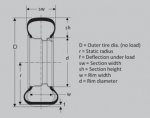I ran the calculations for the lead/lag ratio for the B1750, using the inter axle ratio furnished by Kubota (see post above), and rolling circumference for the factory Firestone Turf and Field tires, as furnished by Firestone. The calcs are as follows:
For the 29x12.50-15 rear tires (with a RC of 86 inches) and 20.5x8.00-10 front tires (with a RC of 61 inches) -->
61 x 1.528 = 93.208
93.208 / 86 = 1.0838.
Therefore, with 29x12.50-10 rear tires, the B1750 comes from the factory with a 8.38 percent front lead or overrun.
For the 31x13.50-15 rear tire option (wth a RC of 93) and 20.5.8.00-10 front tires (with a RC of 61 inches) -->
61 x 1.528 = 93.208
93.208 / 93 = 1.0022
Therefore, with 31.13.50-15 rear tires, the B1750 comes from the factory with essentially a zero lead/lag ratio.
If the inter axle ratio furnished by Kubota is correct, and the rolling circumferences furnished by Firestone are correct, it appears that Kubota is not overly concerned about maintaining a 1 - 5 percent lead for the front tires. Of course, I'm not a mathematician and could have crunched the numbers incorrectly.
For the B7300, the results would be:
61 x 1.475 = 89.975
89.975 / 86 = 1.0462
Therefore, the front wheel lead for the B7300 would be 4.62 percent, using factory tires.
I don't know what to make of these calculations. But, it appears to me that the Kubota engineers don't always follow the customary "2 percent lead is ideal " design philosophy.
Note that both the B7300 and B1750 came from the factory with Firestone Turf & Field 20.5x8.00-10 tires in the front. For the rear tire, the B1750 specifies either 29x12.5-15 or 31. 13.5-15. For the B7300, the only rear tire option is the 29x12.5-15. Perhaps this makes sense because when I run the calcs, the 31 inch rear tire on the B7300 would result in a substantial front lag situtation, which appears to be very bad.


